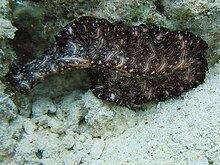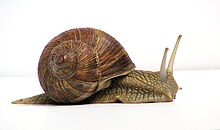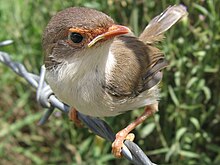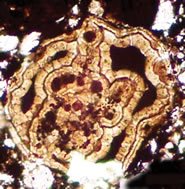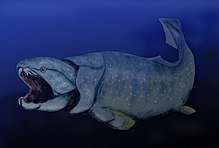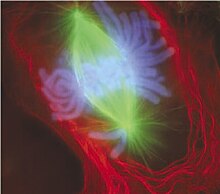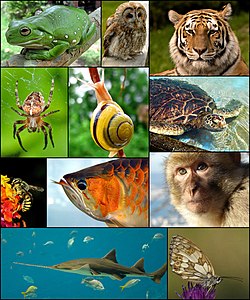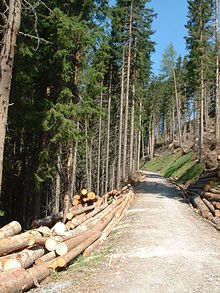Mimicry or pseudo-sematic colours
Further information: Mimicry, sexual selection
Some hawk-cuckoos resemble sparrow-hawks.
 The fact that animals with distant affinities may more or less closely resemble each other was observed long before the existing explanation was possible. Its recognition is implied in a number of insect names with the termination -formis, usually given to species of various orders which more or less closely resemble the stinging hymenoptera. The usefulness of the resemblance was suggested in Kirby and Spences Introduction to Entomology, London, 1817, ii. 223. H.W. Bates (Trans. Linn. Soc. vol. XXiII., 1862, p. 495) first proposed an explanation of mimicry based on the theory of natural selection. He supposed that every step in the formation and gradual improvement of the likeness occurred in consequence of its usefulness in the struggle for life. This was one of the first attempts to apply the theory of natural selection to a large class of phenomena up to that time well known but unexplained. Numerous examples of mimicry among tropical American butterflies were discussed by Bates in his paper; and in 1866 Wallace extended the hypothesis to the butterflies of the tropical East (Trans. Linn, Soc. vol. xxv., 1866, p. 19). The term mimicry is used in various senses. It is often extended, as indeed it was by Bates, to include all the superficial resemblances between animals and any part of their environment. Wallace, however, separated the cryptic resemblances already described, and the majority of naturalists have followed this convenient arrangement. In cryptic resemblance an animal resembles some object of no interest to its enemy (or prey), and in so doing is concealed; in mimicry an animal resembles some other animal which is specially disliked by its enemy, or some object which is specially attractive to its prey, and in so doing becomes conspicuous. Some naturalists have considered mimicry to include all superficial likenesses between animals, but such a classification would group together resemblances which have widely different uses.
The fact that animals with distant affinities may more or less closely resemble each other was observed long before the existing explanation was possible. Its recognition is implied in a number of insect names with the termination -formis, usually given to species of various orders which more or less closely resemble the stinging hymenoptera. The usefulness of the resemblance was suggested in Kirby and Spences Introduction to Entomology, London, 1817, ii. 223. H.W. Bates (Trans. Linn. Soc. vol. XXiII., 1862, p. 495) first proposed an explanation of mimicry based on the theory of natural selection. He supposed that every step in the formation and gradual improvement of the likeness occurred in consequence of its usefulness in the struggle for life. This was one of the first attempts to apply the theory of natural selection to a large class of phenomena up to that time well known but unexplained. Numerous examples of mimicry among tropical American butterflies were discussed by Bates in his paper; and in 1866 Wallace extended the hypothesis to the butterflies of the tropical East (Trans. Linn, Soc. vol. xxv., 1866, p. 19). The term mimicry is used in various senses. It is often extended, as indeed it was by Bates, to include all the superficial resemblances between animals and any part of their environment. Wallace, however, separated the cryptic resemblances already described, and the majority of naturalists have followed this convenient arrangement. In cryptic resemblance an animal resembles some object of no interest to its enemy (or prey), and in so doing is concealed; in mimicry an animal resembles some other animal which is specially disliked by its enemy, or some object which is specially attractive to its prey, and in so doing becomes conspicuous. Some naturalists have considered mimicry to include all superficial likenesses between animals, but such a classification would group together resemblances which have widely different uses.The resemblance of a mollusc to the coral on which it lives, or an external parasite to the hair or skin of its host, would be procryptic; that between moths which resemble lichen, syncryptic; between distasteful insects, synaposematic; between the Insectivor mole and the Rodent mole-rat, syntechnic; the essential element in mimicry is that it is a false warning (pseud-aposematic) or false recognition (pseudepisematic) character.
Some have considered that mimicry indicates resemblance to a moving object; but apart from the non-mimetic likenesses between animals classified above, there are ordinary cryptic resemblances to drifting leaves, swaying bits of twig, etc., while truly mimetic resemblances are often specially adapted for the attitude of rest. Many use the term mimicry to include synaposematic as well as pseudo-sematic resemblances, calling the former Müllerian, the latter Batesian, mimicry. The objection to this grouping is that it takes little account of the deceptive element which is essential in mimicry. In synaposematic colouring the warning is genuine, in pseudaposematic it is a sham. The term mimicry has led to much misunderstanding from the fact that in ordinary speech it implies deliberate imitation. The production of mimicry in an individual animal has no more to do with consciousness or taking thought than any of the other processes of growth. Protective mimicry is here defined as an advantageous and superficial resemblance of one animal to another, which latter is specially defended so as to be disliked or feared by the majority of enemies of the groups to which both belong. Resemblance which appeals to the sense of sight, sometimes to that of hearing, and rarely to smell, but does not extend to deep-seated characters except when the superficial likeness is affected by them. Mutatis mutandis, this definition will apply to aggressive (pseudepisematic) resemblance. The conditions under which mimicry occurs have been stated by Wallace.
- that the imitative species occur in the same area and occupy the same station as the imitated;
- that the imitators are always the more defenceless;
- that the imitators are always less numerous in individuals;
- that the imitators differ from the bulk of their allies;
- that the imitation, however minute, is external and visible only, never extending to internal characters or to such as do not affect the external appearance.
It is proposed, in conclusion, to give an account of the broad aspects of mimicry, and attempt a brief discussion of the theories of origin of each class of facts (see Poulton, Linn. Soc. Journ. Zool., 1898, p. 558). It will be found that in many cases the argument here made use of applies equally to the origin of cryptic and sematic colours. The relationship between these classes has been explained: mimicry is, as Wallace has stated (Darwinism, London, 1889), merely an exceptional form of protective resemblance. Now, protective (cryptic) resemblance cannot be explained on any of the lines suggested above, except natural selection; even sexual selection fails, because cryptic resemblance is especially common in the immature stages of insect life. But it would be unreasonable to explain mimetic resemblance by one set of principles and cryptic by another and totally different set. Again, it may be plausible to explain the mimicry of one butterfly for another on one of the suggested lines, but the resemblance of a fly or moth to a wasp is by no means so easy, and here selection would be generally conceded; yet the appeal to antagonistic principles to explain such closely related cases would only be justified by much direct evidence. Furthermore, the mimetic resemblances between butterflies are not haphazard, but the models almost invariably belong only to certain sub-families, the Danainae and Acraeinae in all the warmer parts of the world, and, in tropical America, the Ithomiinae and Heliconiinae as well. These groups have the characteristics of aposematic species, and no theory but natural selection explains their invariable occurrence as models wherever they exist. It is impossible to suggest, except by natural selection, any explanation of the fact that mimetic resemblances are confined to changes which produce or strengthen a superficial likeness. Very deep-seated changes are generally involved, inasmuch as the appropriate instincts as to attitude, etc., are as important as colour and marking. The same conclusion is reached when we analyse the nature of mimetic resemblance and realize how complex it really is, being made up of colours, both pigmentary and structural, pattern, form, attitude and movement. A plausible interpretation of colour may be wildly improbable when applied to some other element, and there is no explanation except natural selection which can explain all these elements. The appeal to the direct action of local conditions in common often breaks down upon the slightest investigation, the difference in habits between mimic and model in the same locality causing the most complete divergence in their conditions of life. Thus many insects produced from burrowing larvae mimic those whose larvae live in the open. Mimetic resemblance is far commoner in the female than in the male, a fact readily explicable by selection, as suggested by Wallace, for the female is compelled to fly more slowly and to expose itself while laying eggs, and hence a resemblance to the slow-flying freely exposed models is especially advantageous. The facts that mimetic species occur in the same locality, fly at the same time of the year as their models, and are day-flying species even though they may belong to nocturnal groups, are also more or less difficult to explain except on the theory of natural selection, and so also is the fact that mimetic resemblance is produced in the most varied manner. A spiderant, by a modification of its body-form into a superficial resemblance, and by holding one pair of legs to represent antennae; certain bugs (Hemiptera) and beetles have also gained a shape unusual in their respective groups, a shape which superficially resembles an ant; a Locustid (Myrmecophana) has the shape of an ant painted, as it were, on its body, all other parts resembling the background and invisible; a Membracid (Homoptera) is entirely unlike an ant, but is concealed by an ant-like shield. When we further realize that in this and other examples of mimicry the likeness is almost always detailed and remarkable, however it is attained, while the methods differ absolutely, we recognize that natural selection is the only possible explanation hitherto suggested. In the cases of aggressive mimicry an animal resembles some object which is attractive to its prey. Examples are found in the flower-like species of mantis, which attract the insects on which they feed. Such cases are generally described as possessing alluring colours, and are regarded as examples of aggressive (anticryptic) resemblance, but their logical position is here. resembles its model, an
Male and female Goldie's Bird of Paradise
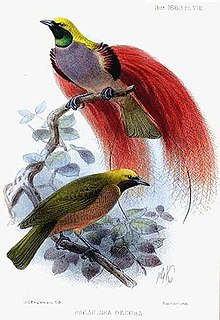 Darwin suggested the explanation of these appearances in his theory of sexual selection (The Descent of Man, London, 1874). The rivalry of the males for the possession of the females he believed to be decided by the preference of the latter for those individuals with especially bright colours, highly developed plumes, beautiful song, etc. Wallace did not accept the theory, but believed that natural selection, either directly or indirectly, accounts for all the facts. Probably the majority of naturalists follow Darwin in this respect. The subject is most difficult, and the interpretation of a great proportion of the examples in a high degree uncertain, so that a very brief account is here expedient. That selection of some kind has been operative is indicated by the diversity of the elements into which the effects can be analysed. The most complete set of observations on epigamic display was made by George W and Elizabeth G Peckham upon spiders of the family Attidae (Nat. Hist. Soc. of Wisconsin, vol. i., 1889). These observations afforded the authors conclusive evidence that the females pay close attention to the love-dances of the males, and also that they have not only the power, but the will, to exercise a choice among the suitors for their favour. Epigamic characters are often concealed except during courtship; they are found almost exclusively in species which are diurnal or semi-diurnal in their habits, and are excluded from those parts of the body which move too rapidly to be seen. They are very commonly directly associated with the nervous system; and in certain fish, and probably in other animals, an analogous heightening of effect accompanies nervous excitement other than sexual, such as that due to fighting or feeding. Although there is epigamic display in species with sexes alike, it is usually most marked in those with secondary sexual characters specially developed in the male. These are an exception to the rule in heredity, in that their appearance is normally restricted to a single sex, although in many of the higher animals they have been proved to be latent in the other, and may appear after the essential organs of sex have been removed or become functionless. This is also the case in the Aculeate Hymenoptera when the reproductive organs have been destroyed by the parasite Stylops. Wallace suggested that they are in part to be explained as recognition characters, in part as an indication of surplus vital activity in the male. More recent theories by the likes of W. D. Hamilton and Amotz Zahavi (see handicap principle) have also been proposed.
Darwin suggested the explanation of these appearances in his theory of sexual selection (The Descent of Man, London, 1874). The rivalry of the males for the possession of the females he believed to be decided by the preference of the latter for those individuals with especially bright colours, highly developed plumes, beautiful song, etc. Wallace did not accept the theory, but believed that natural selection, either directly or indirectly, accounts for all the facts. Probably the majority of naturalists follow Darwin in this respect. The subject is most difficult, and the interpretation of a great proportion of the examples in a high degree uncertain, so that a very brief account is here expedient. That selection of some kind has been operative is indicated by the diversity of the elements into which the effects can be analysed. The most complete set of observations on epigamic display was made by George W and Elizabeth G Peckham upon spiders of the family Attidae (Nat. Hist. Soc. of Wisconsin, vol. i., 1889). These observations afforded the authors conclusive evidence that the females pay close attention to the love-dances of the males, and also that they have not only the power, but the will, to exercise a choice among the suitors for their favour. Epigamic characters are often concealed except during courtship; they are found almost exclusively in species which are diurnal or semi-diurnal in their habits, and are excluded from those parts of the body which move too rapidly to be seen. They are very commonly directly associated with the nervous system; and in certain fish, and probably in other animals, an analogous heightening of effect accompanies nervous excitement other than sexual, such as that due to fighting or feeding. Although there is epigamic display in species with sexes alike, it is usually most marked in those with secondary sexual characters specially developed in the male. These are an exception to the rule in heredity, in that their appearance is normally restricted to a single sex, although in many of the higher animals they have been proved to be latent in the other, and may appear after the essential organs of sex have been removed or become functionless. This is also the case in the Aculeate Hymenoptera when the reproductive organs have been destroyed by the parasite Stylops. Wallace suggested that they are in part to be explained as recognition characters, in part as an indication of surplus vital activity in the male. More recent theories by the likes of W. D. Hamilton and Amotz Zahavi (see handicap principle) have also been proposed.





